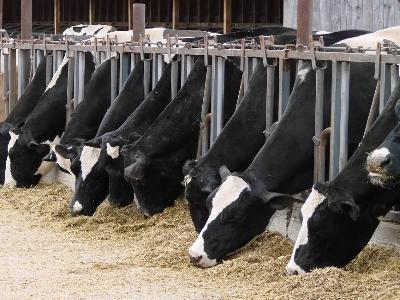How feed efficient is your dairy cow?

ne_fall_photos | Bigstockphotos.com
Dairy farmers in the Netherlands can find out the feed efficiency of the offspring of sires, values that are included in the breeding value and could contribute to more sustainable milk production.
After years of research by Wageningen UR Livestock Research, Dutch dairy farmers can now find out the feed efficiency of the offspring of the country’s dairy bulls. This will help the farmer boost profitability from milk production, and contribute to more sustainable production of animal proteins to feed a growing world population.
This new information puts the Netherlands among the leaders for breeding values by giving information on how much more – or less – the offspring of sires eat for their production and maintenance. It will aid the selection of more efficient dairy cows.
On its own, the breeding value for feed intake would be of little value because it does not distinguish between a high-yielding cow and a heavier one. The former produces more milk while the latter uses more of its feed for maintenance. However, combining the value for feed intake with those for milk production, liveweight and body condition will identify the best candidates for selection and avoid the overly thin and low producers.
For Dutch dairy farmers, the main advantage will be in terms of reduced feed costs, which is the biggest variable cost in milk production. This benefit will gain in importance and value if feed costs rise and milk prices drop as predicted. Selecting more efficient cows will help to lower the cost of production of milk.
Wageningen University ran its first investigation into the merits of estimating a breeding value for feed intake from existing data in 2009. Since then, work has continued on its Dairy Campus and through international collaborations, with financing of Productschap Zuivel.
Genetic Evaluation Sires (GES) publishes breeding values for dairy sires in the Netherlands and Flanders, offering information on breeding values for production, conformation, longevity, fertility and health traits. The breeding values are published in collaboration with Interbull.
Australia first with breeding values for feed intake
Based on genomics, Australia published the world’s first Feed Saved Australian Breeding Value (ABV) in April 2015, according to Dairy Futures CRC. Like Wageningen, Feed Saved ABV incorporates real feed intake data, as well as a prediction of feed required for maintenance purposes. All of the selection indexes from the Australian Dairy Herd Improvement Scheme (ADHIS) now include the Feed Saved ABV.
By choosing elite bulls, Australian farmers are able to breed for greater feed efficiency, but there is a further benefit. Cows identified as having a higher feed conversion efficiency through the Feed Saved ABV will also tend to have lower methane emissions. This will help the dairy industry contribute to national greenhouse emission reduction targets. Further work aims to enable selection of animals with better tolerance to heat stress.
Có thể bạn quan tâm
 Benefits of fiber-degrading enzymes in dairy cow diets
Benefits of fiber-degrading enzymes in dairy cow diets The addition of enzymatic feed additives to dairy cow diets increase feed intake, animal performance. Enzymes can improve feed efficiency and reduce the cost of
 How animal feed enzymes can improve producer profitability
How animal feed enzymes can improve producer profitability The specific roles of phytases, carbohydrases and protease result in numerous benefits for animals and producers.
 EU dairy industry milk crisis impacting feed production
EU dairy industry milk crisis impacting feed production Compound feed producers feel pain of dairy surpluses since the end of EU milk quota system.